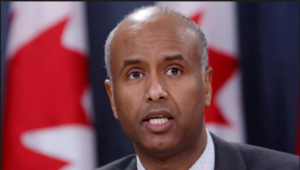Canada will welcome nearly one million immigrants over the next three years, according to the multi-year strategy tabled by the Liberal government today in what it calls “the most ambitious immigration levels in recent history.”
The targets for economic migrants, refugees and family members was tabled in the House of Commons Wednesday afternoon.
Hussen said the new targets will bring Canada’s immigration to nearly one per cent of the population by 2020, which will help offset an aging demographic. He called it a historic and responsible plan and “the most ambitious” in recent history.
“Our government believes that newcomers play a vital role in our society,” Hussen said. “Five million Canadians are set to retire by 2035 and we have fewer people working to support seniors and retirees.”
In 1971 there were 6.6 people of working age for each senior, Hussen said, but by 2012 that ratio had gone to 4.2 to 1 and projections show it will be at 2 to 1 by 2036, when almost 100 per cent of population growth will be a result of immigration; it stands at about 75 per cent today.
Hussen said immigration drives innovation and strengthens the economy, rejecting some claims that newcomers drain Canada’s resources and become a burden on society.
He said the government is also working to reduce backlogs and speed up the processing of applications in order to reunite families and speed up citizenship applications.
“At arriving at these numbers we listened very carefully to all stakeholders who told us they want to see an increase but they also want to make sure that each and every newcomer that we bring to Canada — bringing a newcomer to Canada is half of the job. We have to make sure that people are able to be given the tools that they need to succeed once they get here,” he said.

Luiz Capitulino, 11, of Brazil joins others take the oath as they become official Canadians during a citizenship ceremony at the National Arts Centre in Ottawa on Sept. 25, 2017. The federal government will welcome 310,000 newcomers to Canada in 2018. (Sean Kilpatrick/Canadian Press)
Dory Jade, the CEO of the Canadian Association of Professional Immigration Consultants, welcomed the news although he suggested the numbers should be higher.
“Canada will greatly prosper and grow once the 350,000 threshold has been crossed,” he said. “Nevertheless, we are witnessing a very positive trend.”
The Canadian Council of Refugees also welcomed the news, but wanted more, saying the share for refugees was only increased slightly from 13 per cent this year to 14 per cent in each of the next three years.
Calls for longer-range forecast
In past, there has been a one-year figure for how many immigrants will be permitted into the country, but provinces and stakeholders have called for longer-range forecasts.
Immigration Minister Ahmed Hussen assures an audience in Toronto that funding for immigrant integration will rise with the higher numbers of immigrants 0:17
A statement from Ontario’s Immigration Minister Laura Albanese, before the announcement, said the province supports the introduction of multi-year levels plans “to provide more predictability to the immigration system and inform program planning.”
“Significant variation in year-to-year immigration levels can dramatically impact the requirement for provincial year-to-year resources. A longer term outlook would help in planning for appropriate service levels and use of resources.”
The statement said Ontario supports growth in immigration levels, particularly in economic immigration categories to support the growing economy.
Diversity drives innovation
During the government’s consultation period, the Canadian Immigrant Settlement Sector Alliance presented “Vision 2020,” what it called a “bold” three-year plan to address growing demographic shifts underway in the country, calling for increased numbers in the economic, family and refugee categories.
It recommended a target of 350,000 people in 2018, which climbs to 400,000 in 2019 and 450,000 by 2020.
Chris Friesen, the organization’s director of settlement services, said it’s time for a white paper or royal commission on immigration to develop a comprehensive approach to future immigration.
“Nothing is going to impact this country [more] besides increased automation and technology than immigration will and this impact will grow in response to [the] declining birth rate, aging population and accelerated retirements,” he told CBC News.
–




